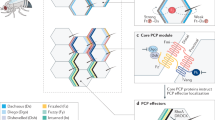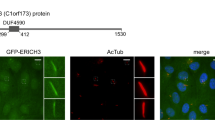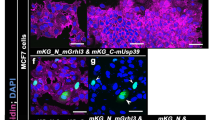Abstract
The planar cell polarity (PCP) signalling pathway is essential for embryonic development because it governs diverse cellular behaviours, and 'core PCP' proteins, such as Dishevelled and Frizzled, have been extensively characterized1,2,3,4. By contrast, the 'PCP effector' proteins, such as Intu and Fuz, remain largely unstudied5,6. These proteins are essential for PCP signalling, but they have never been investigated in mammals and their cell biological activities remain entirely unknown. We report here that Fuz mutant mice show neural tube defects, skeletal dysmorphologies and Hedgehog signalling defects stemming from disrupted ciliogenesis. Using bioinformatics and imaging of an in vivo mucociliary epithelium, we established a central role for Fuz in membrane trafficking, showing that Fuz is essential for trafficking of cargo to basal bodies and to the apical tips of cilia. Fuz is also essential for exocytosis in secretory cells. Finally, we identified a Rab-related small GTPase as a Fuz interaction partner that is also essential for ciliogenesis and secretion. These results are significant because they provide new insights into the mechanisms by which developmental regulatory systems such as PCP signalling interface with fundamental cellular systems such as the vesicle trafficking machinery.
This is a preview of subscription content, access via your institution
Access options
Subscribe to this journal
Receive 12 print issues and online access
$209.00 per year
only $17.42 per issue
Buy this article
- Purchase on Springer Link
- Instant access to full article PDF
Prices may be subject to local taxes which are calculated during checkout





Similar content being viewed by others
References
Wallingford, J. B. Planar cell polarity, ciliogenesis and neural tube defects. Hum. Mol. Genet. 15, R227–R234 (2006).
Karner, C., Wharton, K. A., Jr. & Carroll, T. J. Planar cell polarity and vertebrate organogenesis. Semin. Cell Dev. Biol. 17, 194–203 (2006).
Simons, M. & Mlodzik, M. Planar cell polarity signaling: from fly development to human disease. Annu. Rev. Genet. 42, 517–540 (2008).
Collier, S. & Gubb, D. Drosophila tissue polarity requires the cell-autonomous activity of the fuzzy gene, which encodes a novel transmembrane protein. Development 124, 4029–4037 (1997).
Lee, H. & Adler, P. N. The function of the frizzled pathway in the Drosophila wing is dependent on inturned and fuzzy. Genetics 160, 1535–1547 (2002).
Park, T. J., Haigo, S. L. & Wallingford, J. B. Ciliogenesis defects in embryos lacking inturned or fuzzy function are associated with failure of planar cell polarity and Hedgehog signaling. Nature Genet. 38, 303–311 (2006).
Park, T. J., Mitchell, B. J., Abitua, P. B., Kintner, C. & Wallingford, J. B. Dishevelled controls apical docking and planar polarization of basal bodies in ciliated epithelial cells. Nature Genet. 40, 871–879 (2008).
Hamblet, N. S. et al. Dishevelled 2 is essential for cardiac outflow tract development, somite segmentation and neural tube closure. Development 129, 5827–5838 (2002).
Kibar, Z. et al. Ltap, a mammalian homolog of Drosophila Strabismus/Van Gogh, is altered in the mouse neural tube mutant Loop-tail. Nature Genet. 28, 251–255 (2001).
Huangfu, D. et al. Hedgehog signalling in the mouse requires intraflagellar transport proteins. Nature 426, 83–87 (2003).
Ross, A. J. et al. Disruption of Bardet-Biedl syndrome ciliary proteins perturbs planar cell polarity in vertebrates. Nature Genet. 37, 1135–1140 (2005).
Ansley, S. J. et al. Basal body dysfunction is a likely cause of pleiotropic Bardet-Biedl syndrome. Nature 425, 628–633 (2003).
Sharma, N., Berbari, N. F. & Yoder, B. K. Ciliary dysfunction in developmental abnormalities and diseases. Curr. Top. Dev. Biol. 85, 371–427 (2008).
Smith, U. M. et al. The transmembrane protein meckelin (MKS3) is mutated in Meckel-Gruber syndrome and the wpk rat. Nature Genet. 38, 191–196 (2006).
Beales, P. L. et al. IFT80, which encodes a conserved intraflagellar transport protein, is mutated in Jeune asphyxiating thoracic dystrophy. Nature Genet. 39, 727–729 (2007).
Takeda, S. et al. Left-right asymmetry and kinesin superfamily protein KIF3A: new insights in determination of laterality and mesoderm induction by kif3A−/− mice analysis. J. Cell Biol. 145, 825–836 (1999).
Rual, J. F. et al. Towards a proteome-scale map of the human protein–protein interaction network. Nature 437, 1173–1178 (2005).
Hayes, J. M. et al. Identification of novel ciliogenesis factors using a new in vivo model for mucociliary epithelial development. Dev. Biol. 312, 115–130 (2007).
Pena-Castillo, L. et al. A critical assessment of Mus musculus gene function prediction using integrated genomic evidence. Genome Biol. 9 (Suppl 1), S2 (2008).
Ginalski, K. Comparative modeling for protein structure prediction. Curr. Opin. Struct. Biol. 16, 172–177 (2006).
Hagiwara, H., Aoki, T., Ohwada, N. & Fujimoto, T. Development of striated rootlets during ciliogenesis in the human oviduct epithelium. Cell Tissue Res. 290, 39–42 (1997).
Rossi, V. et al. Longins and their longin domains: regulated SNAREs and multifunctional SNARE regulators. Trends Biochem. Sci. 29, 682–688 (2004).
Jang, S. B. et al. Crystal structure of SEDL and its implications for a genetic disease spondyloepiphyseal dysplasia tarda. J. Biol. Chem. 277, 49863–49869 (2002).
Gedeon, A. K. et al. Identification of the gene (SEDL) causing X-linked spondyloepiphyseal dysplasia tarda. Nature Genet. 22, 400–404 (1999).
Collins, B. M., McCoy, A. J., Kent, H. M., Evans, P. R. & Owen, D. J. Molecular architecture and functional model of the endocytic AP2 complex. Cell 109, 523–535 (2002).
Pryor, P. R. et al. Molecular basis for the sorting of the SNARE VAMP7 into endocytic clathrin-coated vesicles by the ArfGAP Hrb. Cell 134, 817–827 (2008).
Dougherty, G. W. et al. CLAMP, a novel microtubule-associated protein with EB-type calponin homology. Cell Motil. Cytoskeleton 62, 141–156 (2005).
Chan, S. W., Fowler, K. J., Choo, K. H. & Kalitsis, P. Spef1, a conserved novel testis protein found in mouse sperm flagella. Gene 353, 189–199 (2005).
Fariss, R. N., Molday, R. S., Fisher, S. K. & Matsumoto, B. Evidence from normal and degenerating photoreceptors that two outer segment integral membrane proteins have separate transport pathways. J. Comp. Neurol. 387, 148–156 (1997).
Yang, J. & Li, T. The ciliary rootlet interacts with kinesin light chains and may provide a scaffold for kinesin-1 vesicular cargos. Exp. Cell Res. 309, 379–389 (2005).
Follit, J. A., Tuft, R. A., Fogarty, K. E. & Pazour, G. J. The intraflagellar transport protein IFT20 is associated with the Golgi complex and is required for cilia assembly. Mol. Biol. Cell 17, 3781–3792 (2006).
Nagata, S., Nakanishi, M., Nanba, R. & Fujita, N. Developmental expression of XEEL, a novel molecule of the Xenopus oocyte cortical granule lectin family. Dev. Genes Evol. 213, 368–370 (2003).
Cai, H., Reinisch, K. & Ferro-Novick, S. Coats, tethers, Rabs, and SNAREs work together to mediate the intracellular destination of a transport vesicle. Dev. Cell 12, 671–682 (2007).
Billett, F. S. & Gould, R. P. Fine structural changes in the differentiating epidermis of Xenopus laevis embryos. J. Anat. 108, 465–480 (1971).
Nachury, M. V. et al. A core complex of BBS proteins cooperates with the GTPase Rab8 to promote ciliary membrane biogenesis. Cell 129, 1201–1213 (2007).
Sorokin, S. P. Reconstructions of centriole formation and ciliogenesis in mammalian lungs. J. Cell Sci. 3, 207–230 (1968).
Boyadjiev, S. A. et al. Cranio-lenticulo-sutural dysplasia is caused by a SEC23A mutation leading to abnormal endoplasmic-reticulum-to-Golgi trafficking. Nature Genet. 38, 1192–1197 (2006).
Lang, M. R., Lapierre, L. A., Frotscher, M., Goldenring, J. R. & Knapik, E. W. Secretory COPII coat component Sec23a is essential for craniofacial chondrocyte maturation. Nature Genet. 38, 1198–1203 (2006).
Snell, G., Fekete, E. & Hummel, K. The relation of mating, ovulation and the estrus smear in the house mouse to the time of day. Anat. Rec. 76, 30–54 (1948).
Wilson, J. Embryological considerations in teratology. in Teratology: Principles and Techniques. (ed. J. Wilson) 251–277 (University of Chicago Press, Chicago; 1965).
Kimmel, C. A. & Trammel, C. A rapid procedure for routine double staining of cartilage and bone in fetal and adult animals. Stain Technol. 56, 271–273 (1981).
Lee, I., Li, Z. & Marcotte, E. M. An improved, bias-reduced probabilistic functional gene network of baker's yeast, Saccharomyces cerevisiae. PLoS ONE 2, e988 (2007).
Kim, W. K., Krumpelman, C. & Marcotte, E. M. Inferring mouse gene functions from genomic-scale data using a combined functional network/classification strategy. Genome Biol. 9 (Suppl 1), S5 (2008).
Lee, I. et al. A single gene network accurately predicts phenotypic effects of gene perturbation in Caenorhabditis elegans. Nature Genet. 40, 181–188 (2008).
Breitkreutz, B. J. et al. The BioGRID Interaction Database: 2008 update. Nucleic Acids Res. 36, D637–D640 (2008).
Stark, C. et al. BioGRID: a general repository for interaction datasets. Nucleic Acids Res. 34, D535–D539 (2006).
McGuffin, L. J., Bryson, K. & Jones, D. T. The PSIPRED protein structure prediction server. Bioinformatics 16, 404–405 (2000).
McGuffin, L. J. & Jones, D. T. Improvement of the GenTHREADER method for genomic fold recognition. Bioinformatics 19, 874–881 (2003).
Arnold, K., Bordoli, L., Kopp, J. & Schwede, T. The SWISS-MODEL Workspace: A web-based environment for protein structure homology modelling. Bioinformatics 22, 195–201 (2006).
Sive, H. L., Grainger, R. M. & Harland, R. M. Early Development of Xenopus laevis: A Laboratory Manual. (Cold Spring Harbor Press, NY, 2000).
Acknowledgements
The ES cell clone for making the Fuz mutant mouse was provided by Lexicon Pharmaceuticals. We thank P. Paukstelis for aid with structural modelling, S. Vokes for critical comments on the manuscript, and Wei H. for technical help with histology and immunostaining. Phil Abitua is supported by a Diversity Supplement from the NIH/NIGMS. This work was supported by grants to K.J.L from the Wellcome Trust and the BBSRC; to E.M.M. from the NSF, NIH, Welch Foundation (F-1515), Texas Institute for Drug and Diagnostic Development, and a Packard Fellowship; grants to J.B.W. from the NIH/NIGMS, The March of Dimes, The Burroughs Wellcome Fund, the Sandler Program for Asthma Research, and the Texas Advanced Research Program; and by grants to R.H.F. from the NIH and The Texas A&M Institute for Genomic Medicine.
Author information
Authors and Affiliations
Contributions
R.S.G., P.B.A., B.J.W., H.L.S.-R., K.J.L., E.M.M., J.B.W., and R.H.F. designed and interpreted the experiments. R.S.G. performed frog embryo manipulations, construct generation, immunostaining, confocal imaging, structure homology modelling, and protein interactome analysis. P.B.A. performed electron microscopy and EM image analysis. B.J.W. and R.H.F. bred the mice and performed phenotype characterization. B.W.J., H.L.S.-R., K.J.L., R.S.G., and J.B.W. performed mouse immunostaining and imaging. O.B. performed co-immunoprecipiations. G.S.W., I.L., and E.M.M. performed gene network analysis. J.B.W. and R.S.G. assembled figures and wrote the manuscript.
Corresponding authors
Ethics declarations
Competing interests
The authors declare no competing financial interests.
Supplementary information
Supplementary Information
Supplementary Information (PDF 1795 kb)
Rights and permissions
About this article
Cite this article
Gray, R., Abitua, P., Wlodarczyk, B. et al. The planar cell polarity effector Fuz is essential for targeted membrane trafficking, ciliogenesis and mouse embryonic development. Nat Cell Biol 11, 1225–1232 (2009). https://doi.org/10.1038/ncb1966
Received:
Accepted:
Published:
Issue Date:
DOI: https://doi.org/10.1038/ncb1966
This article is cited by
-
Mutant GGGGCC RNA prevents YY1 from binding to Fuzzy promoter which stimulates Wnt/β-catenin pathway in C9ALS/FTD
Nature Communications (2023)
-
Microbial dysbiosis and the host airway epithelial response: insights into HIV-associated COPD using multi’omics profiling
Respiratory Research (2023)
-
Identification of a novel variant of the ciliopathic gene FUZZY associated with craniosynostosis
European Journal of Human Genetics (2022)
-
Wnt/planar cell polarity signaling controls morphogenetic movements of gastrulation and neural tube closure
Cellular and Molecular Life Sciences (2022)
-
Planar cell polarity pathway in kidney development, function and disease
Nature Reviews Nephrology (2021)



